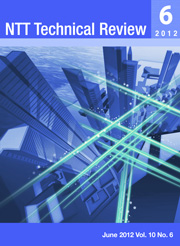
You need Adobe Reader 7.0 or later in order to read PDF files on this site.
If Adobe Reader is not installed on your computer, click the button below and go to the download site.

|

Feature Article: Latest Development Trend at NTT Access Network Service Systems Laboratories
-
 Technology for Reconnecting Optical Fiber Cable in Existing Aerial Closures Technology for Reconnecting Optical Fiber Cable in Existing Aerial Closures

Abstract
We have developed a technology for connecting short remnant lengths of optical fiber that enables the reconnection of optical fiber cable in existing aerial drop closures, which is currently difficult because the remnant length is insufficient.
-
 Versatile Optical Fiber Cabling Technologies for Existing Buildings Versatile Optical Fiber Cabling Technologies for Existing Buildings

Abstract
We have developed a single 8-core low-friction indoor optical cable for high-precision cabling and a range of enhanced modules (E modules), which can be installed as demand requires. These versatile technologies overcome the problems encountered in the provision of optical fiber cabling to customers in small to medium-sized multi-dwelling units owing to the limited free space in existing conduits in customers' buildings. These technologies are also applicable for cabling in large buildings.
-
 Direct Spectrum Division Transmission for High-capacity Satellite Communications Direct Spectrum Division Transmission for High-capacity Satellite Communications

Abstract
We investigated direct spectrum division transmission (DSDT) for satellite communications. A DSDT-based satellite communication system can be made by modifying the design of the existing satellite communication system by inserting a DSDT adapter between the modem and antenna. On the transmitter side, the DSDT adapter divides the modem's output signal into multiple sub-spectra and assigns them to unused frequency resources. On the receiver side, the divided sub-spectra are combined and the original signal is regenerated. Therefore, the DSDT system utilizes existing satellite communication system components and achieves higher frequency utilization efficiency. Experiments on a prototype DSDT adapter show that its resulting bit error rate performance is close to that in the case without spectrum division. The results demonstrate that the DSDT adapter achieves flexible spectrum division and hence enables high-capacity satellite communications.
Regular Articles
-
 4.6-¦Ìm-band Light Source for Greenhouse Gas Detection 4.6-¦Ìm-band Light Source for Greenhouse Gas Detection

Abstract
This article describes a compact mid-infrared light source based on difference-frequency generation with a quasi-phase-matched LiNbO3 waveguide for detecting N2O gas. We obtained stable output power of 0.62 mW with an internal conversion efficiency of 5.9%/W for a 4.6-μm-band continuous-wave light source operating at room temperature. We demonstrated that this light source enables successful detection of N2O gas at concentrations as low as 35 parts per billion. This light source is promising for highly sensitive in-situ continuous monitoring of N2O, and it is also applicable to the detection of other greenhouse gases.
-
 Jubatus: Scalable Distributed Processing Framework for Realtime Analysis of Big Data Jubatus: Scalable Distributed Processing Framework for Realtime Analysis of Big Data

Abstract
This article describes a distributed machine learning framework called Jubatus for deep realtime analysis of big data that we are jointly developing with Preferred Infrastructure Corporation. The main challenge for Jubatus is to achieve scalable distributed computing for profound analytical processing such as online machine learning algorithms and provide a common framework for different supported algorithms. After giving an overview of Jubatus, this article focuses on a key mechanism called mix, which is a new synchronization method among servers to scale out online machine learning algorithms, which are potentially difficult to distribute and parallelize. It synchronizes servers loosely and has a relaxed consistency to the extent allowed by the performance and learning accuracy requirements. This article also evaluates performances such as throughput and scalability and verifies the degree to which the consistency requirement is relaxed.
Global Standardization Activities
-
 Standardization Activities Related to Machine-to-Machine Communications Standardization Activities Related to Machine-to-Machine Communications

Abstract
Machine-to-Machine (M2M) communications, which enables autonomous information exchange between machines via telecommunications networks, is currently receiving attention from diverse industries as a valid mechanism for supporting the future information society. M2M-related services are being launched by telecommunications operators in Japan and abroad, and relevant standardization activities are in progress at a number of standardization organizations and forums. This article mainly introduces M2M-related trends and M2M standardization activities.
Practical Field Information about Telecommunication Technologies
-
 Cable Damage during Deicing of a Handhole Cable Damage during Deicing of a Handhole

Abstract
This article introduces a case study of cable damage during the deicing of a handhole and offers recommendations for damage-free deicing. It is the eleventh in a bimonthly series on the theme of practical field information about telecommunication technologies. This month's contribution is from the Materials Engineering Group, Technical Assistance and Support Center, Maintenance and Service Operations Department, Network Business Headquarters.
External Awards
|
